
Urban Green Spaces: The Future of Outdoor Living in European Cities by 2025
Introduction to Urban Green Spaces
Urban Green Spaces, the future of outdoor living in European cities by 2025, is a concept that has gained significant attention in recent years. As the world becomes increasingly urbanized, the need for green spaces in cities has become more pressing. Urban green spaces refer to areas of vegetation, such as parks, gardens, and green roofs, that are integrated into the urban environment. These spaces provide a range of benefits, including improving air quality, mitigating the urban heat island effect, and enhancing biodiversity.
The Benefits of Urban Green Spaces
The benefits of urban green spaces are numerous and well-documented. Some of the most significant advantages include:
- Improved air quality: Urban green spaces can help to remove pollutants from the air, improving the health and wellbeing of city residents.
- Mitigation of the urban heat island effect: Green spaces can help to cool cities by providing shade and reducing the amount of heat that is absorbed by built surfaces.
- Enhanced biodiversity: Urban green spaces can provide habitats for a range of plant and animal species, helping to maintain biodiversity in urban areas.
- Improved mental health: Spending time in green spaces has been shown to have a positive impact on mental health, reducing stress and improving mood.
Examples of Urban Green Spaces in European Cities
There are many examples of urban green spaces in European cities that are worth highlighting. Some of the most notable include:
- The High Line in London: An elevated park built on an old rail line, providing a green oasis in the heart of the city.
- The Park de la Ciutadella in Barcelona: A large public park that features a range of green spaces, including a lake, a fountain, and several walking trails.
- The Prater in Vienna: A large public park that features a range of green spaces, including a stadium, a amusement park, and several walking trails.
The Future of Urban Green Spaces in European Cities
As we look to the future, it is clear that urban green spaces will play an increasingly important role in European cities. With the increasing recognition of the benefits of green spaces, cities are beginning to prioritize their development and maintenance. Some of the trends that are likely to shape the future of urban green spaces include:
- Increased use of green roofs and walls: Green roofs and walls can provide additional green spaces in cities, helping to mitigate the urban heat island effect and improve air quality.
- Greater emphasis on community engagement: Urban green spaces will be designed to engage with local communities, providing opportunities for recreation, education, and social interaction.
- More focus on biodiversity: Urban green spaces will be designed to provide habitats for a range of plant and animal species, helping to maintain biodiversity in urban areas.
Conclusion
Urban Green Spaces, the future of outdoor living in European cities by 2025, is a concept that has the potential to transform the way we live and interact with our urban environments. By prioritizing the development and maintenance of green spaces, cities can improve the health and wellbeing of their residents, while also helping to mitigate the impacts of climate change. As we look to the future, it is clear that urban green spaces will play an increasingly important role in shaping the future of outdoor living in European cities.






